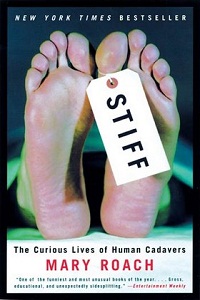“Stiff” by Mary Roach Chapter Questions
"Stiff: The Curious Lives of Human Cadavers" is a non-fiction book written by Mary Roach. Published in 2003, it explores the various ways human cadavers are used in scientific research, medical education, and other fields. Roach approaches the subject with a blend of humor, curiosity, and sensitivity, providing readers with a fascinating and sometimes macabre look into the world of cadaver research.
 Introduction
Introduction
a. Explain what the author meant when she said she saw “her mother’s cadaver”.
Chapter 1 -- A Head Is a Terrible Thing to Waste
a. Why is it important that the doctors (and students) learn to objectify the bodies?
b. What is the malar fat pad and why might plastic surgeons focus on this area?
c. How has surgery changed since the 17th century?
Chapter 2 – Crimes of Anatomy
a. How do medical schools encourage respect for the dead? (or do they?)
b. How were cadavers acquired before the modern day “donation” method?
c. What was Robert Knox’s fatal PR blunder?
d. What options did early surgeons have to learn anatomy when government does not sanction human dissection?
Chapter 3 - Life After Death
a. What is autolysis?
b. Why do bodies bloat? (And do dead people really fart?)
c. How are the dead prepared for burial?
d. What is the scientific purpose for understanding how bodies decay?
Chapter 4 – Dead Man Driving
a. Why are cadavers used to test vehicle crashes?
b. Why are side impacts particularly dangerous?
c. Why are “pieces” of cadavers sometimes used instead of the whole cadaver?
Chapter 5 - Beyond the Black Box
a. What kind of information is included in the Aerospace Pathology book?
b. How is that information useful to investigators?
c. What happens to a body when it hits water after falling from an extreme height?
d. Why do airlines not install features that would make flying safer?
Chapter 6 - The Cadaver Who Joined the Army
a. Why are large caliber bullets preferred over smaller ones?
b. Why do people (and some animals) fall to the ground after being shot?
c. Why are frangible bullets so devastating to the human body?
d. What scientific value does bullet research on cadavers have?
Chapter 7 – Holy Cadaver
a. What experiments were performed to determine the physiological effects of crucifixion?
Chapter 8 – How to Know If You’re Dead
a. What is a beating-heart cadaver?
b. Why were “waiting mortuaries” necessary?
c. Why is the heart given so much credit for being the seat of life (or the soul)?
d. What is the modern definition of death?
e. Why did the author call the cadaver a dead hero?
Chapter 9 – Just a Head
a. What experiments were performed to determine if a severed head still retained consciousness?
b. What scientific value do these experiments have?
Chapter 10 – Eat Me
a. Before the scientific method was used, what information did doctors use to prescribe remedies for various illnesses?
b. Describe one of these dubious remedies and explain why it might have actually worked.
c. What are some reasons that cannibalism exists?
Chapter 11 – Out of the Fire and Into the Compost Bin
a. What is tissue digestion and how is it accomplished?
b. What are the potential benefits of composting the dead?
c. Where does the water inside a human (or cadaver) come from? Where does it go?
Chapter 12 – Remains of the Author
a. How are human skeletons prepared (from real bodies)?
b. What is plastination?
